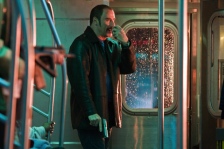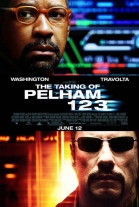The Taking of Pelham 123
|  In this third crack at John Godey’s 1973 novel about the hijacking of a New York City subway, director Tony Scott imposes his signature stylistic grab bag of spastic random zooms, machine-gun editing, bleary slow motion, and other assorted forms of needless visual assault on what is already an exciting, nervy premise. There is rarely a moment in the film that Scott doesn’t pour on the overkill, and when he lets the camera rest for a moment or holds on a shot for longer than a few seconds, it is a relief that allows you to slip back into the tension without being smacked upside the head by it. In this third crack at John Godey’s 1973 novel about the hijacking of a New York City subway, director Tony Scott imposes his signature stylistic grab bag of spastic random zooms, machine-gun editing, bleary slow motion, and other assorted forms of needless visual assault on what is already an exciting, nervy premise. There is rarely a moment in the film that Scott doesn’t pour on the overkill, and when he lets the camera rest for a moment or holds on a shot for longer than a few seconds, it is a relief that allows you to slip back into the tension without being smacked upside the head by it.Because of Scott’s reliably indiscriminant overdirection, which he has actually dialed down from his previous films (most notably 2005’s incoherent Domino), The Taking of Pelham 123 only works in fits and starts. It also suffers from not operating in the pre-Disney sleaze of New York City in the 1970s, which provided the fuel for similarly paranoid urban nightmares such as Dirty Harry (1971) and Death Wish (1974), the latter of which opened a mere three months after Joseph Sargent’s gritty 1974 original film version (there is also a 1998 made-for-TV version, but the very fact that it was shot in Toronto immediately eliminates it from genuine consideration). Screenwriter Brian Helgeland, who also adapted a novel for Scott’s Man on Fire (2004), alters most of the original characters and their motivations and also updates the scenario with minor plot points involving the Internet and webcams, but largely declines to play up the potential fear-of-another-9/11 angle by limiting the characters to a few brief references to the idea of “terrorism” and then letting it drop. One of the movie’s strong points is its immediacy. There is literally no set-up, as the opening credits roll over a frantic montage that quickly introduces us to transit authority dispatcher Walter Garber (Denzel Washington), who is going about his daily routine monitoring subway traffic while Ryder (John Travolta), a surly hulk with a porn-star handlebar moustache and knife-like sideburns, and his motley crew (including Luis Guzmán, Victor Gojcaj, and Ramon Rodriguez) hijack the Pelham 123 subway and hold 18 people hostage. Garber is drawn into the scenario because he happens to be on the microphone when it all goes down, thus he is on the receiving end of Ryder’s harsh, no-nonsense demand that he be paid $10 million in an hour or else he will start offing passengers at the rate of one per minute. While Scott certainly plays up the action when available (a smashed car careening off a bridge, a climactic runaway subway threatening to derail), much of the movie consists of a series of tense verbal standoffs between Garber and Ryder. The movie is defined, in fact, not so much by motion as it is by stasis, as Ryder has stopped the subway car in the middle of the tracks and holds his position even as the SWAT team takes aim from all directions. Garber, on the other hand, is trapped at the transit authority’s high-tech nervous center because Ryder refuses to talk to anyone but him. He certainly doesn’t want to talk to Camonetti (John Turturro), the NYPD hostage negotiator whose tactics Ryder already knows by heart, although he is willing to spend a few moments berating the Mayor, who is played by James Gandolfini as a worn-down mixture of Michal Bloomberg and Rudy Giuliani. Even though Ryder has made his demands clear, it is hard not to suspect that there is more to them, and the gradual revelation of who he is and what his actual goals are provides an underlying slow burn to the film’s otherwise hectic surface. Travolta constantly threatens to overplay the role of the murderous villain (as he did so memorably in John Woo’s Face/Off), but he manages to effectively balance Ryder’s willingness to go the distance with the underlying seething anger he uses to justify his actions. Washington, on the other hand, has a more restrained role, although he has the benefit of playing a decent character who may in fact be morally compromised by a bad decision from the recent past. With his slightly lumpy appearance and frumpy wardrobe, Washington is clearly playing Garber as the quintessential everyman who, when pushed into extraordinary circumstances, has the potential to act extraordinarily. The fact that The Taking of Pelham 123 gives him more than a few opportunities to do exactly that is not particularly surprising, but Scott handles the climactic showdown with requisite intensity and even finds a moment of quiet, simple grace on which to end the movie, which is almost enough to make you forget how overcooked the rest of it has been. Copyright ©2009 James Kendrick Thoughts? E-mail James Kendrick All images copyright © Columbia Pictures |
Overall Rating: 

 (2.5)
(2.5)


